|
HII Regions:
Hydrogen is the most common material in the Universe, and can be found in virtually
every environment investigated by astronomers, from the regions surrounding
black holes, in stars and galaxies, as an important component in clusters of galaxies,
and spread on large scales through the universe itself. Three states of hydrogen, HI, HII and
H2, are often referred to by astronomers, and mean:
- HI - unionized form of hydrogen
- HII - ionized form of hydrogen
- H2 - molecular hydogen
Much of the Hydrogen in galaxies can be detected via the 21-cm spin-flip which is studied by radio telescopes. Using radio telescopes and maping the spin-flip transitions, we are able to map the shape
of our galaxy.
HII regions exist most commonly in the disk of a spiral galaxy. For an HII
region to exist, there must be a source to proved the ionizing heat required to
strip the electron, so HII regions are common near very hot stars. As a result, HII regions can be very hot, around ~10,000K. Such areas are emission nebula. These areas of starbirth are strong in UV radiation. Newly formed stars within the spiral of a galaxy are literally blown away from its association with other stars formed in the same "nursury." A great example of this is the Orion Nebula.
As for molecular clouds, 99% of their composition is in the form of molecular hydrogen (H2). The rest include over 60 other molecules such as H20, SO2, HCN, CS, H2CO, CO, CN, SiO, OH, H2S, and many other variations of H, C, N and O.
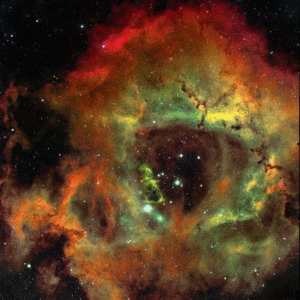 |
False color image of the Rosette nebula (NGC2237) in the
constellation Monoceros (the Unicorn) taken in the light of hydrogen a,
[O III], and [S II], (red, green and blue). The Rosette is a prominent
star formation region, glowing due to ultraviolet light from the young,
hot, blue stars whose winds also cleared the central hole.
Image Credit. |
Star forming regions like the Orion Nebula are best viewed in the infrared:
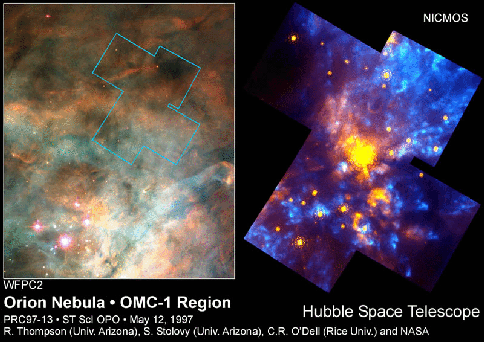
In this case, the HII clouds (blue) are surrounding hot, young stars
(yellow).
Old galaxies - like elliptical type galaxies - will have little HII regions
as star birth and supernova would have either used up or cleared away these
areas.
For ionization of hydrogen to occur, ultraviolet photons (with a temperature
from 10,000 K to 60,000 K) are needed. White dwarf stars (the stellar remnant of
normal stars) have a temperature near 200,000 K and are also very good at
ionizing hydrogen. Examples of these are planetary nebula:
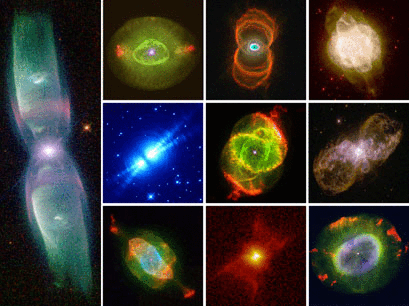
This montage of Hubble Space Telescope images demonstrate the wide variety of
planetary nebulae. In addition to ionized hydrogen, other debris surrounding a
planetary are oxygen, nitrogen, silicone, and helium.
Ionization and Emission Lines (C.
Flynn, 2005):
H II regions have a certain size around an ionizing source which is a balance
between the flux of ionizing photons on one hand, and the rate at which the
plasma can cool and the ionized electrons can re-combine with the protons. If
the ionization rate is greater than the recombination rate, then the plasma will
become almost fully ionized. Studies indicate that less than a per cent of the
hydrogen remains unionized in typical regions.
 |
| Three spiral galaxies imaged in a broad band red filter (top
panels) and the light of Ha (bottom panels). HII
regions are remarkably tightly correlated with the spiral and ring like
structures in the galaxies. The red filter is more sensitive to the general
distribution of old stars, while the Ha filter
highlights the sites of young stars in star forming regions. |
Ultra-violet photons below a wavelength of l = 912
Å, have sufficient energy to ionize hydrogen, removing the electron from the
ground shell. The electron is eventually recaptured, but because interstellar
gas is of such low density, this can take some time.
Hot stars are the best sources of the UV photons needed to ionize the gas. In
practice this means very early type stars, such as O and B stars, and white
dwarfs. The surfaces of the O and B stars range in temperature from 10,000 to
60,000 K, while white dwarfs can reach surface temperature of up to 200,000 K.
Recombination leads to emission lines, as shown in figure
8.
Important ones are Ha at 6563 Å, [N II] at 6583 Å, [O
II] at 3726 and 3729 Å and [O III] at 4959 and 5007 Å.
|
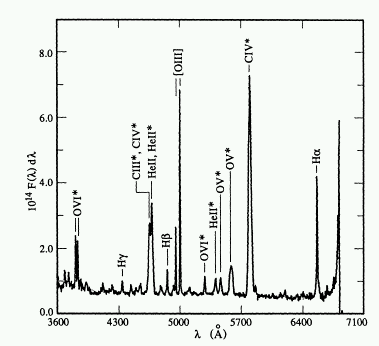
|
| Spectrum of a typical planetary nebula, NGC 1501, showing many
narrow emission lines of H, C, O and He. Source : Stanghellini, Kaler and
Shaw, A&A, 291, 604. |
A special notation has been used here, the square brackets, "[ ]''. This
indicates that the line is normally "forbidden'', meaning it is only seen in
very low density conditions. In the laboratory, plasmas are generally of such
high density that these line are not seen. The lines originate from energy
states just above the ground state, and are meta-stable with long lifetime.
The emission lines form very useful diagnostics of the physical conditions in
the the gas. For example, the [O III] and [N III] lines are temperature
sensitive, while [O II] and [S II] (at 6716 and 6731 Å) are more sensitive
to the electron density. This is because the latter lines are emitted at
different levels but with nearly the same excitation energy, so that their
relative ratio is a diagnostic of the collisional de-excitation, or the density,
of the gas. The plasmas are found to be very thin by terrestrial standards, with
particle densities of order 10 to 106 cm-3.
Observations at radio wavelengths are very interesting, because these regions
typically emit bremsstrahlung radiation at these frequencies, giving an
excellent independent probe of the temperatures and electron densities in the
clouds.
Examples of Bremsstrahlung:
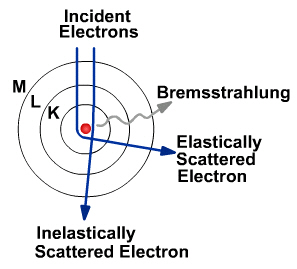
(Image
Credit)
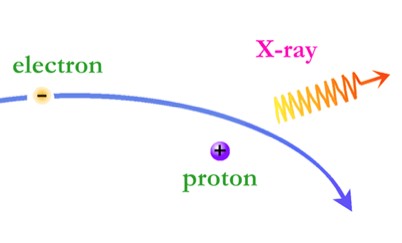
(Image
Credit)
Bremsstrahlung is the German word for "braking
radiation." As a free electron interacts with a proton, the electron is slowed
(but not captured) releasing a photon.
Back to Top
|

